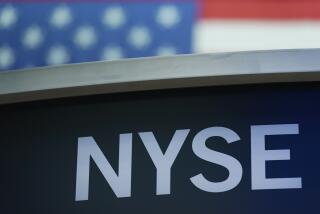Heavy Intervention Fails to Stem Dollar’s Climb
WASHINGTON — The United States and its major economic allies launched another round of concerted dollar selling Tuesday to help stem a new surge in the currency’s value, but they were decidedly unsuccessful--at least in their initial attempt.
Led by the Federal Reserve Board, central banks of most of the seven largest industrial countries intervened repeatedly in major currency markets. But the dollar, buoyed by signs of economic strength at home and uncertainties abroad, continued to soar.
By the end of the trading day, the dollar had closed at 146.75 Japanese yen and 1.9875 West German marks, just slightly below the peaks it had reached in the Frankfurt and Tokyo markets earlier in the day.
Moreover, many analysts said, the dollar could push even higher today--possibly above the psychologically important barriers of 2 marks and 150 yen to the dollar.
Richard Witten, vice president and chief of currency trading for Goldman Sachs & Co., a New York investment banking firm, said there technically are “no fundamental constraints” to prevent the dollar from moving “reasonably higher.”
He said the dollar easily could reach 2.02 marks or 153 yen early in the day.
Tuesday’s intervention came partly at the urging of the Bush Administration, which fears that too sharp an increase in the dollar’s value could hurt U.S. trade competitiveness. A high dollar makes U.S. exports more expensive and makes imports more attractive in the United States.
The Fed, which is believed to have entered the markets on at least three occasions Tuesday, is expected to mount an even bigger challenge today or Thursday if the dollar’s rise continues.
If that does not work, private analysts said, West Germany may soon be forced to consider increasing its domestic interest rates to prop up the West German mark on international markets.
Karl Otto Poehl, president of the Bundesbank, West Germany’s central bank, has been loath to take such a step because it could exacerbate inflation and slow the West German economy. Poehl said last week that the dollar’s value is not important to West Germany.
The central banks acted after the dollar had soared Monday and early Tuesday, partly on the strength of a Friday report showing that U.S. job growth is continuing at a healthy pace--a situation that analysts say suggests that interest rates are not likely to decline.
Above Upper Limits
Traders have also been worried about drug-related tensions in Colombia, which tend to push investors to the dollar as a safe-haven currency, and about reports that some Federal Reserve officials believe that U.S. interest rates should rise more.
The shift on the part of traders pushed the dollar from 145.60 Japanese yen on Friday to a high of 147.15 during the Tuesday trading day. At the same time, the U.S. currency surged to a high of 1.99 West German marks during the day, up from 1.9778 at the end of last week.
The dollar now appears to be conspicuously above the upper limits established for it by finance ministers and central bankers of the Group of Seven--the United States, West Germany, Japan, Britain, France, Italy and Canada.
Although the ministers have never disclosed the ranges, they are believed to be 120 to 140 yen and 1.6 to 1.9 marks to the dollar.
Senior officials of the seven industrial countries have said they are seeking to stabilize the dollar within those ranges, which have prevailed for the past year and a half, and will take whatever measures are needed to keep it generally within them.
This week’s bout between the markets and central banks was the first in more than a month. The dollar moved upward in May and June, from a low of 132.6 yen and 1.8925 marks in April, before falling slightly in mid-July. It has been rising again since early August.
There was no immediate indication of how extensively the industrial nations intervened in the currency markets. But traders said they sensed that it was sizable, suggesting that the central banks wanted to signal that they were serious about trying to stabilize the U.S. currency.
More to Read
Inside the business of entertainment
The Wide Shot brings you news, analysis and insights on everything from streaming wars to production — and what it all means for the future.
You may occasionally receive promotional content from the Los Angeles Times.










